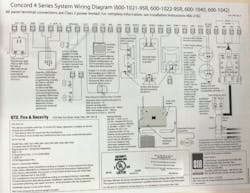Class action lawsuit filed against GE Electric Co. over alleged defective alarm control units
A disabled veteran from New Jersey has filed a class action lawsuit against General Electric Co., alleging “dangerous and serious defects, dangers and non-conformities” were present in all combination-listed burglar and fire alarm system control units sold under the brand name Interlogix.
The units named in the suit were manufactured and sold by GE Electric Co., United Technologies Corp., UTC Fire & Security Americas Corp. (doing business as Interlogix) and Carrier Global Corp.
The plaintiff, Samuel L. Kaplan of Teaneck, N.J., alleges in the 8-count, 144-page lawsuit that there “defects, dangers and non-comformities” with Interlogix alarm system control units made and sold by GE from 2002 through 2009 under the GE Security name; United Technologies Corp. from 2010 through 2015 under the Interlogix brand name; UTC Security from late 2015 through early 2020 under the Interlogix brand name; and then by Carrier under the Interlogix brand name after UTC Security was spun off into Carrier in early 2020.
The lawsuit alleges the companies knew about or were required to know about the problems for years, and that the issues can lead to “instantaneous and catastrophic failure of the alarm system’s combination-listed control unit during a fire.
“In this dangerously silent and non-functional state, instead of the alarm system performing its crucial life safety function by audibly warning all occupants inside the home of the fire emergency and the central station, the combination listed control unit fails.
“Consequently, the alarm system cannot warn families of the imminent life safety danger within their home, allowing for their timely escape before the premises become untenable.”
The suit, filed Aug. 30 in U.S. District Court in New Jersey, asserts that the dangers inherent in the control units renders them non-conforming to the minimum standards required by both UL and NFPA 72 Standards.
The filing says that before the companies submitted their equipment to be listed by a Nationally Recognized Testing Laboratory (NRTL) such as UL Underwriters Laboratories, they were required to verify that their equipment was conforming.
The lawsuit said if the data-bus circuit wiring is faulted and/or shorted anywhere it is installed throughout the home by fire, such as in the common areas, in the wall, attic or basement, “the non-conforming control unit is instantly rendered non-functional.
“In gross contrast, if the combination-listed control unit was conforming, fire attacking the single data-bus circuit of the combination listed control unit or any equipment that is required to connect to the single data-bus of the combination listed control unit will not cause the system to be rendered non-functional, since conforming to both UL and NFPA 72 Standards specifically prohibits this loss of functionality from happening.”
The suit alleges the companies being sued “concealed these serious defects, dangers and non-conformities from consumers and/or failed to disclose the alarm system defects to plaintiff and the class, while at the same time affirmatively representing the high quality and safety of their control unit systems meeting both UL and NFPA Standards.”
The companies are also accused of failing to remove the systems from the marketplace or to take remedial action, “even though defendants were aware that the single data-bus circuit of their combination listed control units was non-compliant to UL and NFPA regulations.”
The suit goes on to say the companies marketed and sold their combination-listed control units while still knowing they were “defective and dangerous.”
Kaplan and his attorney are asking a federal judge to certify a proposed nationwide class and New Jersey subclass in relation to the lawsuit.

